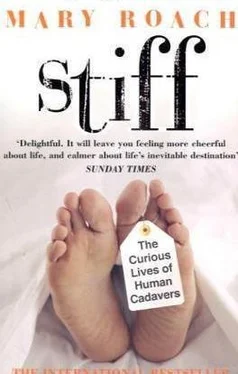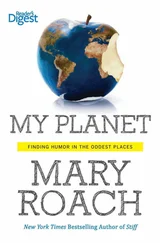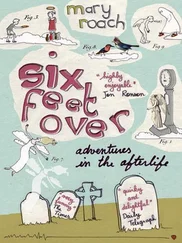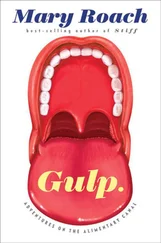What was going on in experiments like these? Hard to say. Perhaps the brain stem or spinal medulla had been left intact. Perhaps Dr. Redi, too, had his brain extracted from a hole in his skull the November past.
People have trouble believing Thomas Edison to be a loopy individual. I offer as evidence the following passage on human memory, taken from his diaries: “We do not remember. A certain group of our little people do this for us. They live in that part of the brain which has become known as the ‘fold of Broca.’ …There may be twelve or fifteen shifts that change about and are on duty at different times like men in a factory…. Therefore it seems likely that remembering a thing is all a matter of getting in touch with the shift that was on duty when the recording was done.”
Unless H’s family is planning a naked open-casket service, no one at her funeral will be able to tell she’s had organs removed. Only with tissue harvesting, which often includes leg and arm bones, does the body take on a slightly altered profile, and in this case PVC piping or dowels are inserted to normalize the form and make life easier for mortuary staff and others who need to move the otherwise somewhat noodleized body.
When he tired of moving organs and heads around, Demikhov moved on to entire dog halves. His book details an operation in which two dogs were split at the diaphragm, their upper and lower halves swapped, and their arteries grafted back together. He explained that this might be less time-consuming than transplanting two or three individual organs.
Given that the patients spinal nerves, once severed, could not be reconnected and the lower half of the body would be paralyzed, the procedure failed to generate much enthusiasm.
Legendary for skewering heads of state, from Kissinger to Arafat (“a man born to irritate”). Fallaci stuck it to White by making up a name for the anonymous lab monkey whose brain she had watched being isolated and for writing things like this: “While [the brain removal and hookup] happened, no one paid any attention to Libby’s body, which was lying lifeless. Professor White might have fed it, too, with blood, and made it survive without a head. But Professor White didn’t choose to, and so the body lay there, forgotten.”
As opposed to the mouse, horse, rat, goose, hog, sheep, mule, donkey, or dog variety. Dog turd was especially popular, particularly dried white dog turd, from which the popular Renaissance medicine Album Graecum was made. The Chinese Materia Medica includes not only dog turd, but the grains and bones extracted from it. These were trying times for pharmacists.
If you could at all help it, it was extremely advisable, historically, to avoid being epileptic. Treatments for it have included distilled human skull, dried human heart, bolus of human mummy, boy’s urine, excrement of mouse, goose, and horse, warm gladiator blood, arsenic, strychnine, cod liver oil, and borax.
While I am thankful to be alive in the era of antibiotics and over-the-counter Gyne-Lotrimin, I am saddened by modern medicine’s contributions to medical nomenclature. Where once we had scrofula and dropsy, now we have supraven-tricular tachyarrhythmia and glossopharyngeal neuralgia. Gone are quinsy, glanders, and farcy. So long, exuberant granulations and cerebral softening. Fare-thee-well, tetter and hectic fever. Even the treatments used to have an evocative, literary flavor. The Merck Manual of 1899 listed “a tumblerful of Carlsbad waters, sipped hot while dressing” as a remedy for constipation and the lovely, if enigmatic, “removal inland” as a cure for insomnia.
You don’t see the Sims position anymore, but you can see Dr. Sims, who lives on as a statue in Central Park in New York. If you don’t believe me, you can look it up yourself, on page 56 of The Romance of Proctology . (Sims was apparently something of a dilettante when it came to bodily orifices.)
P.S.: I could not, from cursory skimming, ascertain what the romance was.
He does not use the word “autopsy,” for the prefix denotes a postmortem medical inspection of one’s own species. Technically speaking, only a human’s investigation of another human’s death can be called an autopsy—or, supposing a very different world, a sheep’s investigation of another sheep’s.
In the grand scheme of industrial air pollution, crematoria rank low on the fret list. They emit about half as much particulate matter as a residential fireplace and about as much nitrous oxide as the typical restaurant grill. (This is not surprising, as the human body is mostly water.) Of greatest concern is mercury from dental fillings, which vaporizes and drifts into the atmosphere at a rate of .23 grams per hour of operation (about a half gram per cremation), according to research done jointly by the EPA and the Cremation Association of North America. An independent study done in England in 1990 and published in the journal Nature estimated the average amount of mercury released into the atmosphere at three grams per cremation—a notably higher and, the author believed, worrisome total. All in all, compared to power plants and incinerated trash, the dental work of the dead generates a small fraction of the planet’s airborne mercury.
Frozen humans shatter easily because they are mostly water. How much water is a matter of some debate. A Google search unearthed sixty-four Web sites with the words “body is 70 percent water,” 27 sites that say it’s 60 percent water, 43 that tell you it is either 80 or 85 percent water, 12 that say the figure is 90 percent, 3 that say it’s 98 percent, and one that says it’s 91 percent. A better consensus exists for jellyfish. They are either 98 or 99 percent water, and that is why you never see dried jellyfish snacks.
Todd Astorino, director of the Exercise Science Program at Salisbury University, in Salisbury, Maryland, was able to answer the question not only with certainty, but to a decimal point: We are 73.8 percent water.
The figure, he said, is calculated by giving a volunteer a measured quantity of water laced with tracers to drink. Four hours later, the subject’s blood is sampled and the dilution of the tracers is noted. From this, you, or Todd anyway, can figure out how much water is in the body. (The more water in the body, the more diluted the tracers in the blood.) Compare the water weight to body weight, and there’s the answer. Isn’t science terrific?
And sometimes less. My business-grade room at Gothenburg’s Landvetter Airport Hotel (“For Flying People”) had no clock, the assumption being, I suppose, that a businessman can simply consult his watch. The TV remote had no mute button. I pictured Swedish remote designers arguing quietly in their cleanly appointed conference room. “But Ingmar, why do you need a special button when you can just put down the volume?”
If you live nearby, by all means donate. The Maxwell Museum holds the world’s only collection of contemporary—within the last fifteen years—human bones, used to study everything from forensics to the skeletal manifestations of diseases. P.S.:Your family can go in and visit your bones, which the staff will lay out for you, though probably not in the shape of an all-together skeleton.












